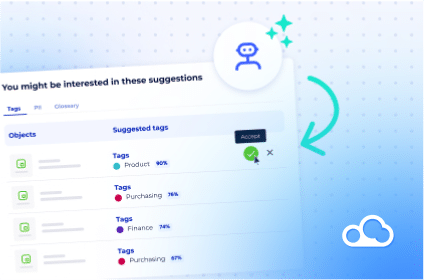In the ever-evolving landscape of data management, two terms have gained significant attention: Data mesh and data fabric. While these concepts share common goals related to data integration and accessibility, they have distinct approaches and applications.
In this article, we will delve into the similarities and differences between data mesh and data fabric, shedding light on their unique characteristics, use cases, and benefits.
What is data mesh?
Data mesh is a relatively new approach to data management and governance that seeks to decentralize data ownership and distribution within organizations. It is a response to the challenges posed by traditional centralized data architectures, which often result in data silos, bottlenecks, and scalability issues.
Data mesh advocates for treating data as a product and promotes the concept of domain-oriented ownership. In a data mesh, cross-functional teams, known as data domains, are responsible for the end-to-end data lifecycle, including data collection, transformation, quality, and distribution. This decentralized model aims to empower individual teams or business units to manage their data autonomously.
Key characteristics of data mesh
- Domain-oriented ownership: In a data mesh, each data domain takes ownership of its data, making it responsible for its quality, governance, and accessibility.
- Self-service data: Data mesh leads to self-service data access, enabling teams to access and use the data they need without extensive reliance on centralized data engineering teams.
- Federated data architecture: Data mesh employs a federated architecture where data domains publish data products that can be discovered and accessed by others in the organization.
- Data as a product: Data is treated as a product, and data domains are responsible for ensuring that the data products they produce are valuable, reliable, and well-documented.
What is data fabric?
Data fabric is another approach to data management that emphasizes data integration, consistency, and accessibility across an organization’s data ecosystem. It is designed to provide a unified and coherent view of data, regardless of its source or location. Data fabric solutions aim to overcome the challenges of fragmented data landscapes and enable organizations to derive insights from their data efficiently.
Data fabric achieves this by creating a virtualized layer that abstracts the underlying data sources and systems, presenting a unified view to data consumers. It seamlessly connects and integrates data from various sources, including on-premises databases, cloud-based applications, streaming data, and more. This integrated approach simplifies data access and accelerates data-driven decision-making.
Key characteristics of data fabric
- Unified data integration: Data fabric solutions offer a unified approach to integrating data from diverse sources, ensuring that data is easily accessible and can be analyzed without complexities.
- Data abstraction: Data fabric abstracts the complexity of underlying data sources, providing data consumers with a simplified and consistent view of data.
- Scalability & agility: Data fabric solutions are highly scalable and agile, accommodating the evolving data needs of organizations as they grow and adapt.
- Data governance & security: Data fabric solutions often include robust data governance and security features to ensure data compliance and protection.
Data mesh vs. data fabric: A comparative analysis
Now that we have a clear understanding of both data mesh and data fabric, let us compare these two approaches across various dimensions.
Data ownership & governance
- Data mesh: Data mesh advocates for domain-oriented ownership, giving individual teams or domains control over their data. This approach can lead to more decentralized data governance, with each domain responsible for its data quality and governance.
- Data fabric: Data fabric provides a centralized view of data and often includes robust data governance capabilities. It allows organizations to establish consistent data policies and access controls across the entire data ecosystem.
Data integration & accessibility
- Data mesh: Data mesh promotes self-serve data access, allowing teams to access and use data autonomously. However, data integration may require collaboration among domains, potentially leading to data silos if not managed effectively.
- Data fabric: Data fabric focuses on seamless data integration and presents a unified view of data, making it readily accessible to users across the organization. It minimizes data silos by design.
Scalability & flexibility
- Data mesh: Data mesh is designed to be highly scalable and adaptable to changing data needs. Each domain operates independently, making it easier to scale individual components.
- Data fabric: Data fabric solutions are also scalable and flexible, accommodating the growth and evolving data landscape of organizations. The virtualized layer simplifies data integration and management as new data sources are added.
Complexity & implementation
- Data mesh: Implementing a data mesh requires a shift in organizational culture and mindset, as well as the establishment of domain-specific data teams. It may involve a more significant cultural transformation.
- Data fabric: Data fabric solutions are typically implemented as technology platforms that abstract data complexities. While there may be technical challenges in integration, the focus is less on organizational culture and more on technology adoption.
Use cases
- Data mesh: Data mesh is particularly suitable for organizations with a need for agility and autonomy in data management. It is often favored by tech-savvy organizations that value data-driven decision-making.
- Data fabric: Data fabric is well-suited for organizations seeking a unified view of data, especially those dealing with complex and diverse data sources. It is often adopted by organizations with a focus on data consistency and compliance.
Choosing the right approach for your company
Choosing between data fabric and data mesh depends on the specific needs an organization has and its culture and goals. It is essential to assess your organization’s data landscape, consider the level of data autonomy required, and evaluate your data governance and compliance requirements.
In some cases, a hybrid approach that combines elements of both data mesh and data fabric may be the most effective solution. Ultimately, the goal is to enable data-driven decision-making, improve data accessibility, and ensure data quality and governance.
The role of data catalogs & metadata management tools
Both data mesh and data fabric can benefit from data catalog and metadata management tools to enhance data discoverability, understanding, and governance.
- Data catalog: A data catalog serves as a centralized repository that indexes and organizes metadata about an organization’s data assets, making it easier for users to discover and access data products.
- Metadata management tools: Metadata management tools capture and manage metadata associated with data assets, including lineage information. This helps organizations maintain a comprehensive understanding of their data and its context.
Conclusion
In the evolving landscape of data management, understanding the distinctions between data mesh and data fabric is crucial. While data mesh emphasizes domain-oriented ownership and autonomy, data fabric focuses on seamless data integration and accessibility. Choosing the right approach depends on the needs and goals of your organization.
By leveraging data catalog and metadata management tools, organizations can enhance their data discoverability, governance, and overall data management practices, regardless of whether they follow a data mesh or data fabric strategy. Ultimately, both approaches aim to harness the power of data for better decision-making and business outcomes in an increasingly data-driven world.
Are you interested in learning even more about using your data as an asset to achieve higher levels of data governance and data quality? Book a demo today to get started on your organization’s journey to complete data lifecycle management with DataGalaxy!





